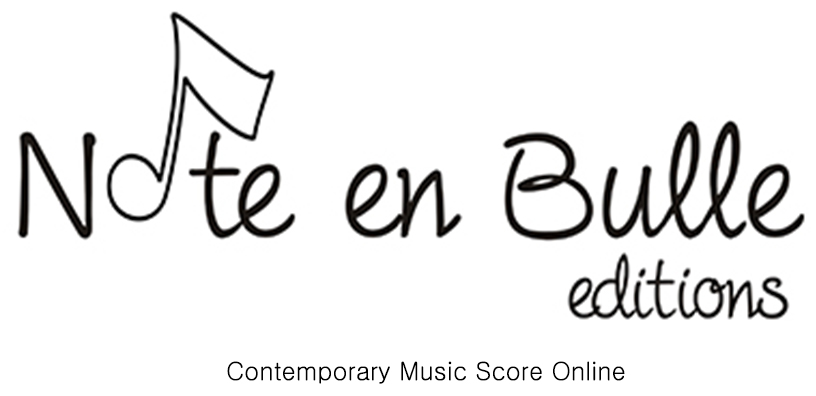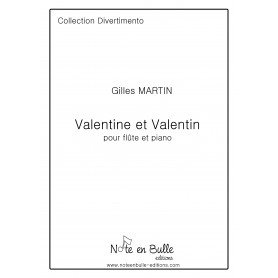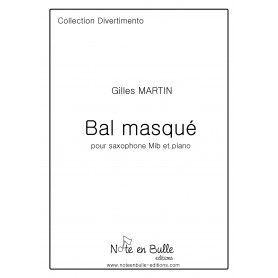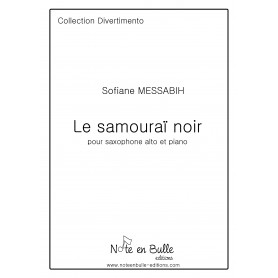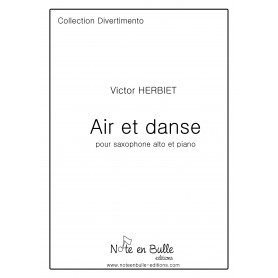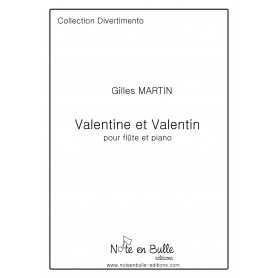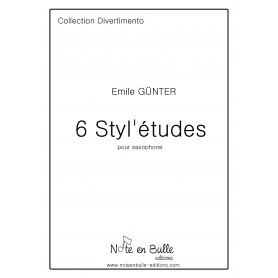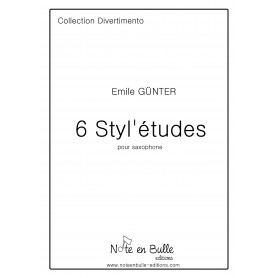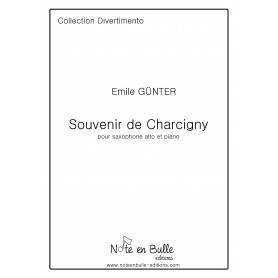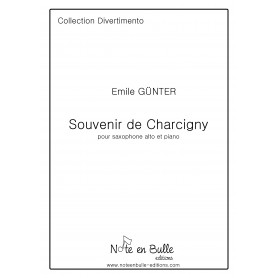Emile Günter
There are 4 products.
Emile Günter 6 Styl'études - PDF
Pdf Version
For saxophone
Duration 24'00
These 6 studies are designed to elaborate a work around various stylistic notions for saxophonists students, which are present in the 20th century saxophone works.These studies can be performed by saxophonist in grade 5 to 7
These studies are a perfect combination of technique and musicality, and are suitable for all saxophones.
The first study is a tonal trip, classical, varying around the neighboring tones of F major, and going to neighboring tones of neighboring tones... The phrases have fun exploring tones sometimes far from the original tone.
In the blues, the use of this mode is a pretext, to break the support points and work around the accents, while swinging.
The Locrian mode is with the Phrygian mode one of the two natural modes, which has a minor second at the beginning of it, what makes it so characteristic. The Locrian mode is a very dissonant mode, it is a Greek mode, present in Jazz, which here is treated as a classical mode. Playing on the first particularity of this mode, that is to say the half-tone between the first and the second degree, this study is articulated on this half-tone to visit different Locrian modes.
With a regular speed of quaver (eight note), and different support points, the phrases go through 4/4, 3/8, 5/8, and other figures. This alternate study approaches particular metrics dear to the countries of Eastern Europe and to Bartok.
The tone scale allowed Debussy, among others, to bring the music of his time into the 20th century. Here, the idea is to go through the two unitonic scales and to make a long musical journey from C to C#.
As the name suggests, the repetition is likely to make more than one of us tangle our fingers... and this by taking up the F major of the first study.
For saxophone
Duration 24'00
These 6 studies are designed to elaborate a work around various stylistic notions for saxophonists students, which are present in the 20th century saxophone works.These studies can be performed by saxophonist in grade 5 to 7
These studies are a perfect combination of technique and musicality, and are suitable for all saxophones.
The first study is a tonal trip, classical, varying around the neighboring tones of F major, and going to neighboring tones of neighboring tones... The phrases have fun exploring tones sometimes far from the original tone.
In the blues, the use of this mode is a pretext, to break the support points and work around the accents, while swinging.
The Locrian mode is with the Phrygian mode one of the two natural modes, which has a minor second at the beginning of it, what makes it so characteristic. The Locrian mode is a very dissonant mode, it is a Greek mode, present in Jazz, which here is treated as a classical mode. Playing on the first particularity of this mode, that is to say the half-tone between the first and the second degree, this study is articulated on this half-tone to visit different Locrian modes.
With a regular speed of quaver (eight note), and different support points, the phrases go through 4/4, 3/8, 5/8, and other figures. This alternate study approaches particular metrics dear to the countries of Eastern Europe and to Bartok.
The tone scale allowed Debussy, among others, to bring the music of his time into the 20th century. Here, the idea is to go through the two unitonic scales and to make a long musical journey from C to C#.
As the name suggests, the repetition is likely to make more than one of us tangle our fingers... and this by taking up the F major of the first study.
10.00
Emile Günter 6 Styl'études - Printed version
Printed Version
For saxophone
Duration 24'00
These 6 studies are designed to elaborate a work around various stylistic notions for saxophonists students, which are present in the 20th century saxophone works.These studies can be performed by saxophonist in grade 5 to 7
These studies are a perfect combination of technique and musicality, and are suitable for all saxophones.
The first study is a tonal trip, classical, varying around the neighboring tones of F major, and going to neighboring tones of neighboring tones... The phrases have fun exploring tones sometimes far from the original tone.
In the blues, the use of this mode is a pretext, to break the support points and work around the accents, while swinging.
The Locrian mode is with the Phrygian mode one of the two natural modes, which has a minor second at the beginning of it, what makes it so characteristic. The Locrian mode is a very dissonant mode, it is a Greek mode, present in Jazz, which here is treated as a classical mode. Playing on the first particularity of this mode, that is to say the half-tone between the first and the second degree, this study is articulated on this half-tone to visit different Locrian modes.
With a regular speed of quaver (eight note), and different support points, the phrases go through 4/4, 3/8, 5/8, and other figures. This alternate study approaches particular metrics dear to the countries of Eastern Europe and to Bartok.
The tone scale allowed Debussy, among others, to bring the music of his time into the 20th century. Here, the idea is to go through the two unitonic scales and to make a long musical journey from C to C#.
As the name suggests, the repetition is likely to make more than one of us tangle our fingers... and this by taking up the F major of the first study.
Pdf version, Click here
For saxophone
Duration 24'00
These 6 studies are designed to elaborate a work around various stylistic notions for saxophonists students, which are present in the 20th century saxophone works.These studies can be performed by saxophonist in grade 5 to 7
These studies are a perfect combination of technique and musicality, and are suitable for all saxophones.
The first study is a tonal trip, classical, varying around the neighboring tones of F major, and going to neighboring tones of neighboring tones... The phrases have fun exploring tones sometimes far from the original tone.
In the blues, the use of this mode is a pretext, to break the support points and work around the accents, while swinging.
The Locrian mode is with the Phrygian mode one of the two natural modes, which has a minor second at the beginning of it, what makes it so characteristic. The Locrian mode is a very dissonant mode, it is a Greek mode, present in Jazz, which here is treated as a classical mode. Playing on the first particularity of this mode, that is to say the half-tone between the first and the second degree, this study is articulated on this half-tone to visit different Locrian modes.
With a regular speed of quaver (eight note), and different support points, the phrases go through 4/4, 3/8, 5/8, and other figures. This alternate study approaches particular metrics dear to the countries of Eastern Europe and to Bartok.
The tone scale allowed Debussy, among others, to bring the music of his time into the 20th century. Here, the idea is to go through the two unitonic scales and to make a long musical journey from C to C#.
As the name suggests, the repetition is likely to make more than one of us tangle our fingers... and this by taking up the F major of the first study.
Pdf version, Click here
20.00
Emile Günter Souvenir de Charcigny - Pdf
Pdf Version
For Alto Saxophone and piano
Duration 4'30
Souvenir de Charcigny is an original work written for alto saxophone and piano for students in grde 3-4.
This work is in 3 parts. It begins with a nostalgic melody in F Major and approaches simple rhythms allowing to work on the conduct of the phrases and the support of the air column.
A short playful cadenza introduces a light, bouncy dance that contrasts with the first part both in character and technique.
Ideal for an exam, this composition uses almost the entire register of the saxophone (low Bb to high F), the main articulations and nuances to be acquired at the end of rade 3, as well as the varied rhythms that are acquired at this level.
Very musical, this work will enchant the students while being a composition which will make it possible to approach a second cyclenext grade in all confidence.
For Alto Saxophone and piano
Duration 4'30
Souvenir de Charcigny is an original work written for alto saxophone and piano for students in grde 3-4.
This work is in 3 parts. It begins with a nostalgic melody in F Major and approaches simple rhythms allowing to work on the conduct of the phrases and the support of the air column.
A short playful cadenza introduces a light, bouncy dance that contrasts with the first part both in character and technique.
Ideal for an exam, this composition uses almost the entire register of the saxophone (low Bb to high F), the main articulations and nuances to be acquired at the end of rade 3, as well as the varied rhythms that are acquired at this level.
Very musical, this work will enchant the students while being a composition which will make it possible to approach a second cyclenext grade in all confidence.
7.00
Emile Günter Souvenir de Charcigny - Printed version
Printed Version
For Alto Saxophone and piano
Duration 4'30
Souvenir de Charcigny is an original work written for alto saxophone and piano for students in grde 3-4.
This work is in 3 parts. It begins with a nostalgic melody in F Major and approaches simple rhythms allowing to work on the conduct of the phrases and the support of the air column.
A short playful cadenza introduces a light, bouncy dance that contrasts with the first part both in character and technique.
Ideal for an exam, this composition uses almost the entire register of the saxophone (low Bb to high F), the main articulations and nuances to be acquired at the end of rade 3, as well as the varied rhythms that are acquired at this level.
Very musical, this work will enchant the students while being a composition which will make it possible to approach a second cyclenext grade in all confidence.
Pdf version, Click here
For Alto Saxophone and piano
Duration 4'30
Souvenir de Charcigny is an original work written for alto saxophone and piano for students in grde 3-4.
This work is in 3 parts. It begins with a nostalgic melody in F Major and approaches simple rhythms allowing to work on the conduct of the phrases and the support of the air column.
A short playful cadenza introduces a light, bouncy dance that contrasts with the first part both in character and technique.
Ideal for an exam, this composition uses almost the entire register of the saxophone (low Bb to high F), the main articulations and nuances to be acquired at the end of rade 3, as well as the varied rhythms that are acquired at this level.
Very musical, this work will enchant the students while being a composition which will make it possible to approach a second cyclenext grade in all confidence.
Pdf version, Click here
16.00
